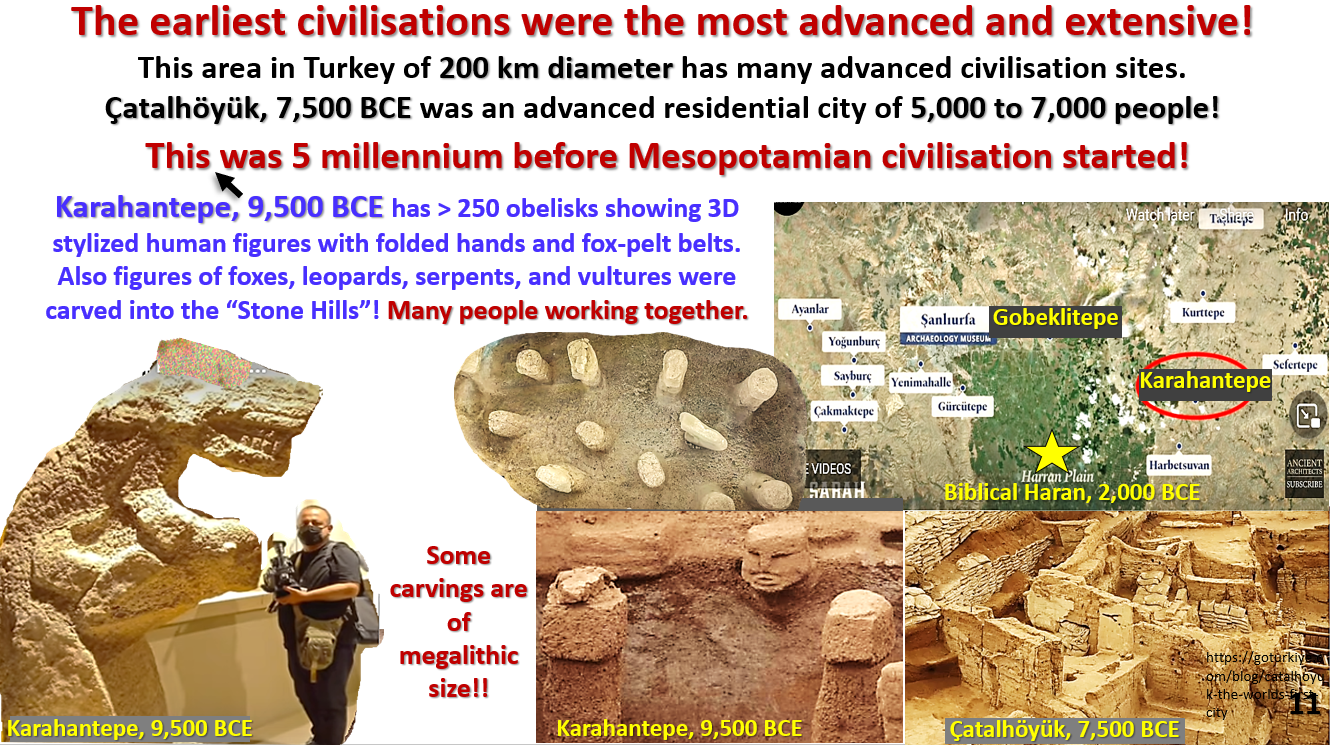Figure 11 (above). Evidence of the advanced,urbanised civilisation at Gobeklitepe, Çatalhöyük and Karahantepe in the Plain of Harran area Turkey.
The Earliest Advanced urbanised civilisation on Earth?
The history of Harran Plain civilisation extends from >10,000 BCE to 1,260 AD. The longest lasting large civilisation on Earth!
This post is the 5th in my AusIMM webinar series (https://www.geotreks.com.au/work/projects-studies/video-links-bob-watchorn-ausimm-webinars-research-discoveries/ Video #6).
It examines the concept that copper mining kickstarted civilisation. We’re still describing the earliest civilisation at Gobeklitepe.
These earliest Harran Plain civilisations are the most advanced and extensive so far found on Earth.
In Turkey the Harran Plain civilisation (Gobeklitepe larger area top-right inset) had a collection of cities and temples covering an area 200 km in diameter or slightly smaller than the size of Ireland or Ceylon and bigger than Netherlands or Israel!!
The advanced residential city of Çatalhöyük (lower-right inset) had 5 to 7,000 people from 7,500 to 6,000 BCE https://whc.unesco.org/en/list/1405/. This is three millennium before Mesopotamian civilisation started.
Karahantepe in 9,500 BCE has 250 obelisks showing 3-D human stylised figures https://www.theartnewspaper.com/2021/11/17/discovery-turkey-karahan-tepe and
https://www.ancient-origins.net/news-history-archaeology/karahantepe-0015904 .
These figures were carved out of solid rock and were up to 5 metres high (centre). This suggests a lot of co-operation and a lot of people working together. The picture in the lower-left shows the size of these mega-fauna figures.
These temples and proto-cities range in age from >10,500 BCE to about 4,500 BCE, about 6,000 years of continuous settlement. This might not sound like a long time but it is a period which takes us from our time back to before the Roman Empire, ancient Egypt and the Sumerian empire. Even the Chinese civilisation has survived unbroken for only a third of this time!
And yet Harran itself survived for another 5,700 years until 1,260 AD when it was destroyed by the Mongol hordes. So the Harran Plains area was occupied as a major capital and centre of learning for 11,700 years!!!!!!!!
A more recent example of the longevity and spread of the Harran Plain area civilisation is in its mention in the Bible that there were arranged marriages between families, from what is now Israel and Haran, by Abraham about 2,000 BCE!
Harran survived as a major capital city with an enlightened, highly educated population until the 13th century https://en.wikipedia.org/wiki/Harran#Early_Islamic_Harran.
Islam…. At the beginning of the Islamic period (7th century CE), Harran was located in the land of the Mudar tribe (Diyar Mudar), the western part of northern Mesopotamia (Jazira). Along with ar-Ruha’ (Şanlıurfa) and Raqqa it was one of the main cities in the region. During the reign of the Umayyad caliph Marwan II, Harran became the seat of the caliphal government of the Islamic empire stretching from parts of Spain to parts of Central Asia…
…. During the late 8th and 9th centuries, Harran was a centre for translating works of astronomy, philosophy, natural sciences, and medicine from Greek to Syriac by Assyrians, and thence to Arabic, bringing the knowledge of the classical world to the emerging Arabic-speaking civilization in the south. Baghdad came to this work later than Harran. Many important scholars of natural science, astronomy, and medicine originated from Harran….
We can thus thank Harran as a ‘centre of learning‘ for the continuation and spread of education and culture throughout the supposed ‘Dark Ages‘.
Crusades …. At the end of 12th century, Harran served together with Raqqa as a residence of Kurdish Ayyubid princes. The Ayyubid ruler of the Jazira, Al-Adil I, again strengthened the fortifications of the castle. In the 1260s, the city was completely destroyed and abandoned during the Mongol invasions of Syria. The father of the famous Hanbali scholar Ibn Taymiyyah was a refugee from Harran, settling in Damascus. The 13th-century Kurdish historian Abu al-Fida describes the city as being in ruins. The early 14th-century traveler Jordanus devotes Chapter 10 of his Mirabilis to “Aran”, which most likely is Harran. The entire chapter reads: “Here Followeth Concerning the Land of Aran. Concerning Aran I say nothing at all, seeing that there is nothing worth noting.”[25]
There are only small settlements at Harran today. The water dried up, or the infrastructure was destroyed by the Mongols, and the area abandoned. Recent irrigation of the Harran Plain has revived the area. An interesting absorbing history which is just starting as only a small portion of the area has been excavated!
The start of (documented) written language on Earth.
Right from the start at Gobeklitepe there is written language. This suggests a long gestation period. This language most likely originated from the advanced precursor flooded civilisations mentioned in the previous sections of this talk. Much more will be discussed on this topic later.
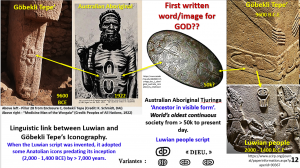
One sure sign of an advanced civilisation is the use of symbols that represent words.
The first known word for God was used at Gobeklitepe. It is seen as two crescent shaped semicircles with a H or an I between them. It is seen on the pillars (top-left) and on the belts and circling the humanoid pillars (top-right) https://www.scirp.org/journal/paperinformation.aspx?paperid=90367 . This is a thought provoking paper on what came first – religious, or technological, thought that gathered people together – which then formed societies which needed agriculture to feed themselves – whew!
The same symbol was the symbol for God used by the Luwian people in the same area (200 km west) from 2,000 – 1,400 BCE over 7,000 years later (lower-left) https://www.redbubble.com/i/canvas-print/Luwian-Hieroglyphic-Script-by-innasoyturk/56085189.56DNM?country_code=US&gclid=EAIaIQobChMI0-3xuoyp9gIVQyQrCh3urwgQEAQYASABEgIHkfD_BwE&gclsrc=aw.ds#&gid=1&pid=2
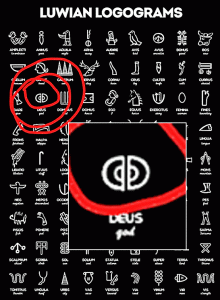
Another interesting facet of this research is that the Australian Aboriginal people also had the same symbol in their language it meant ancestor in invisible form (dubious reference but the picture is authentic http://m.epochtimesph.com/science/australian-aboriginal-symbols-found-on-mysterious-12000-year-old-pillar-in-turkey-a-connection-that-could-shake-up-history.html) .
The aboriginal people have been in Australia for up to 60,000 years. However, the last group to come across would have been between about 4-8,000 BCE before the last sea-level rise. This last ‘incursion’ of Aboriginal people (bringing the Dingo dog) still has 11% DNA that came from India and they settled in the NW of the continent in about 2,000 BCE. https://www.nature.com/articles/nature.2013.12219
They would have had to pass through the general Gobeklitepe cross-roads area to get to India. Thus it is not unreasonable to think that they met the Luwians, or others, who were contemporaneous and learned the God symbol from them??
Another research article said that the aboriginal symbol meant supreme being that travels in the Milky Way. The symbol also means people sitting opposite around a campfire – take your pick?
That or similar symbols meaning God was used all over the world in antiquity. I compiled 12 similar symbols ranging from East Asia to the Americas. Ying/Yang would be an example – a circle split down the middle.
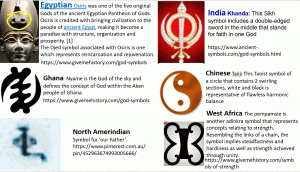
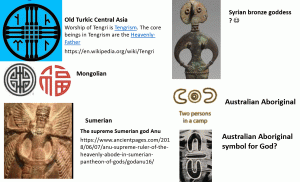
The 9,500 BCE symbol on the pillars at Gobeklitepe looks to be a well-established symbol at that time and which suggests strong civilisation with the written word well before 9,500 BCE.
Advanced planning and construction methods on the Harran Plain!
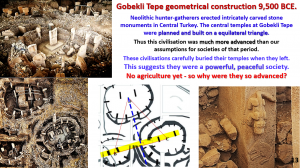
The components of the temple at Gobeklitepe were built on an isosceles triangle formation https://www.smithsonianmag.com/smart-news/ancient-geometry-discovered-worlds-oldest-temple-180974991/ .
This could not have happened by accident and suggests that the temples were built at the same time to an overall plan.
This suggests that they were a powerful, peaceful civilisation. There was no evidence of large-scale organised agricultural practice in the area in 9,500 BC – see below …
…. researchers had long thought that the development of complex social systems like religion only emerged after humans settled down and started making forays into agriculture. But Göbekli Tepe’s age—and a lack of evidence that farming or animal domestication occurred nearby—suggests the coordinated efforts required to build it may have instigated settlement rather than followed it…. https://www.smithsonianmag.com/smart-news/ancient-geometry-discovered-worlds-oldest-temple-180974991/
If there is little agriculture showing in the archaeology of the area, where did they get the funds and the people to build such stupendous temples? Why were they so advanced? Maybe from mining from the nearby native copper and malachite deposits?? The native copper would have been very valuable and would be the excellent trading material needed to buy food, materials and pay workers to build the temples.
After 4 – 6000 years something made the people leave but they very carefully buried their temples before they left.
They buried them so carefully that they were only found 60 years ago and yet they occur in the centre of a 11,000 year old continuously well settled area.
There is much yet to learn about this civilisation!
Share this post with your colleagues and questions are always welcome and answered!
Cheers
Bob Watchorn

